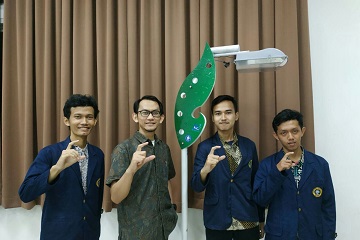IPB Students Invent Street Lamps form Rubber Waste

Liquid waste from rubber industries often become a problem amongst communities around an industrial area. Liquid waste from rubber industries which come from washing the rubber and is automatically disposed of into the surrounding environement causes a strong potent odor. This odor is caused by the decompostion of an organic substance by bacteria or microbes which are found in the proccessed rubber. This also creates air pollution which disturbs the people living around the area and cannot recieve quality air.
A solution in solving this problem is offered by a few students from Bogor Agricultural University (IPB) and the Department of Machine and Biosystem Engineering, Faculty of Agrotechnology (TMB Fateta IPB) which consist of Heksa Julian Satria Darmawan, Affan Afrizal Gani, and Hari Agung Pratama. They process the waste to become a new source of electric energy by using Microbial Fuel Cell (MFC) technology which is than used to light up Light Emitting Diode (LED) street lamps around the rubber industry area.
“This tool that we created is called GLOWER which is an acronym for Gurza Lump Power which is in line with the working mechanism of this tool which utilizes waste from Rubber Washings (Lump) as a organic substrate. Using the Mikrobial Fuel Cell (MFC) system which changes liquid waste from rubber industries into electricity. It comes from the substrate of liquid rubber waste. The output is in the form of street lamps,” says the Team Leader, Heksa Julian Satria Darmawan.
“This technology has been already found before and is still continously developed until now. MFC utilizes the metabolisme of bacteria which produces ions as a way to produce energy. The energy that is produced here is electric energy. Then, we develop the use of this energy to reduce liquid rubber waste,” said one of the team members, Affan Afrizal Gani.
This invention was presented in the Student Creativity Program in the Invention division (PKM-KC) with the title “GLOWER: Waste Power-Lamp using the MFC System as a Solution n Utilizing Liquid Waste from Rubber Industries” under the supervision of Lilis Sucahyo, S/TP. M.Si.
“We utilize two kinds of bacteria from this liquid rubber waste which are Escherichia colli and Shewanella sp with the MFC system. When these bacteria are degrade organic substrates, they produce electrons. These electrons are what we harvest by using carbon catodes and graphite anodes. Then, these electrons are flowed through a series of power regulators, which then light up LED lamps for lighting around the rubber industry area. We chose LED lamps because they are more efficient in giving off light and use the same voltage as the ones that are produced by our GLOWERs,” explains Heksa.
“Our next development will be done by creating an energy storage mechanism by using bacteria which comes from the MFC. Actually, there have been many other inventions that we have already created. But after discussing with our supervising professor it turns out that the ions that are produced from the bacteria’s metabolism can produce metanogen gas which can be used for making biogas,” says one of the team members, Affan Afrizal Gani.
This invention about the development of renewable energy in Indonesia must still be further improved. There are many potentials that can be developed into renewable energy. For example the organic substrates that are utilized by this team in creating an energy source for street lamps.
Indonesia is known as an agricultural country with a bountiful amount of agricultural prouducts. Biomass from agricultural products which are typically used is only used partially for primary uses. For example when corn is harvest, only the corn cob is used and the other parts of the corn go to waste. This shows that the biomass in Indonesia is not yet fully utilized. Therefore, this team’s invention shows that IPB exists as a university which continous to create innovations from waste that is typically not used, into inventions that are beneficial to the environment and the community. (AVR)



